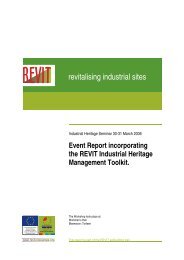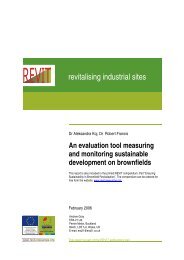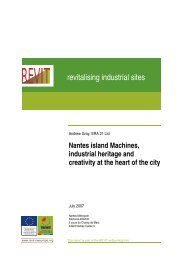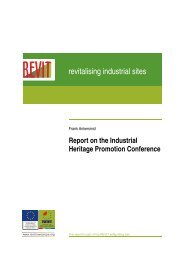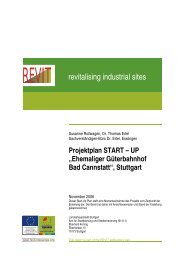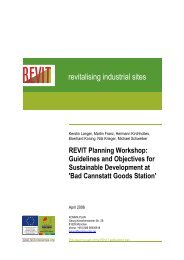REVIT Heritage Report.pdf
REVIT Heritage Report.pdf
REVIT Heritage Report.pdf
You also want an ePaper? Increase the reach of your titles
YUMPU automatically turns print PDFs into web optimized ePapers that Google loves.
Torfaen County Borough Council<br />
<strong>REVIT</strong>: A Review of the Conservation of Industrial <strong>Heritage</strong> Assets on Brownfield Sites<br />
2.1.8 Historic buildings also have an important role to play in developing sustainable<br />
communities. One requirement of sustainable development is that buildings<br />
minimise the use of resources during construction and over time. Historic<br />
buildings represent embodied energy and to recycle them is to capitalise on<br />
investment and energy that has already been expended. Demolition of such<br />
structures is, therefore, an extremely wasteful exercise, particularly when<br />
followed by new-build.<br />
2.1.9 Recent research carried out by the Building Research Establishment in Britain<br />
(BRE) has shown that a typical Victorian-era house contains energy equivalent<br />
to 15,000 litres of petrol (EH, 2003). When seen in these terms, it is clear that<br />
urban regeneration schemes should not just be about creative new designs but<br />
should always include historic buildings for their positive impact on the natural<br />
environment and our finite energy sources.<br />
2.1.10 One of the Key issues identified by the Working Group “Brownfield<br />
Redevelopment” (CLARINET) was:<br />
“Development of methods and skills to respond to the increasing importance of<br />
preserving the industrial heritage in Brownfield projects”.<br />
2.1.11 In addition relevant objectives to industrial heritage include:<br />
• restricting Greenfield consumption by re-using Brownfields;<br />
• preserving the architectural heritage of the industrial revolution by finding<br />
new uses for historic industrial buildings;<br />
• increasing the skills of unemployed people by derelict land recycling, via<br />
the creation of new employment opportunities and<br />
• improvement of environmental quality e.g. by encapsulating or removing<br />
contaminated soil and restoring the landscape distorted by industrial use.<br />
2.1.12 The contribution of heritage to Brownfield regeneration includes:<br />
• provide a community focus for regeneration and act as a catalyst for the<br />
regeneration of the surrounding area;<br />
• create employment and contribute to a fall in vacancy rates in the nearby<br />
business premises;<br />
• contribute to attractive living and working conditions;<br />
• encourage sustainable tourism;<br />
• enhance people's quality of life;<br />
• contribute to social inclusion, learning, health and safe environments;<br />
• contribute to local distinctiveness by linking a place with its industrial past<br />
• develop skills<br />
0014021/JM/001 4




